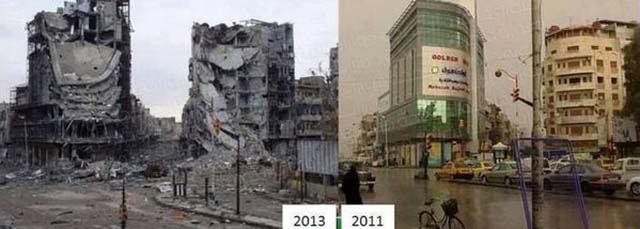The recent diplomatic activity on Syria is intriguing. Russia, Mr. Assad’s most powerful supporter, has forged new ties with Saudi Arabia, his bitter foe and a major funder of Syrian rebel groups, and brokered a meeting between Syrian and Saudi intelligence officials. Even amid high tensions over Ukraine, there was a recent diplomatic engagement between the U.S. and Moscow on the vexing question of how to end Syria’s brutal civil war, which has left more than 250,000 dead, fuelled the rise of the Islamic State, and helped to radicalize would be terrorists around the world. Now Russia is at the centre of a new flurry of Syria focused diplomacy which has followed the Iran nuclear deal, and which might even involve a new round of direct talks between Washington and Tehran, Syria’s staunchest ally. But these diplomatic engagements are also followed by the increased fighting on the ground by all the parties. The fighting has gathered pace recently, intensifying on major frontlines including near Damascus, where a government air strike on a market place killed 100 people, and in the southern city of Deraa, where the government is battling a new rebel attempt to seize the entire city. All are areas of vital importance to President Assad, who with the help of his regional allies Iran and the Lebanese group Hezbollah is seeking to shore up control over western areas of the country after losing much of the rest to groups including Islamic State.
A marked escalation in Syria’s conflict could be a sign the warring sides are trying to strengthen their bargaining positions in case a flurry of diplomacy leads to negotiations. Despite fighting hard on the ground every party in Syrian conflict knows that there is no military solution. They just want to negotiate from position of strength in talks. There have been a number of diplomatic initiatives, some of them secret involving Iran, Saudi Arabia, the United States and Russia who together can end this war aimed at trying to find a political solution to the crisis in Syria. In Qatar, talks were held on Syria between the US Secretary of State, the Russian Foreign Minister and the Saudi Foreign Minister in Oman, one of the few countries in the region with strong ties to both Iran and the Gulf States, Syrian Foreign Minister Walid Muallem held talks after meeting with Iranian and Russian officials in Tehran. The visit has created talk of a possible meeting of Saudi, Syrian and Iranian officials in Muscat. In Riyadh, furthermore, reports have emerged of a landmark meeting of senior Syrian and Saudi intelligence officials; in Moscow there have been a number of high-profile visitors, including the Saudi Foreign Minister and a number of Syrian Opposition leaders; and the Iranian Foreign Minister visited a number of Middle Eastern and South Asian countries to promote a new peace plan.
But what has led to this sudden flurry of diplomatic activity? First of all that it is the realisation that the situation in Syria is simply unsustainable and that there can never be a military solution. However, the recent Iranian nuclear deal has meant that Teheran is now able to play more of a constructive international role and it can certainly contribute to a political settlement in Syria, which it seems it wants to do. Hard fact is that the US, Russia, Saudi Arabia, Iran and Syria all have a common enemy: Islamic State, which is a direct threat to them all and which threatens the entire region. The fact that Islamic State controls half of Syria is extremely worrying and without a political settlement in the country the jihadists will never be defeated. Another key factor is the weakening position of Syrian ruler Bashar ul Assad, who is losing territory and military strength to a variety of opposition groups. Western and even Gulf States fear that groups like Nusra Front and the Islamic State will fill the void if the regime of President Assad falls and that will be the worst case scenario. So the high time for starting a new peace talk’s initiative in Syria is high on agenda of everyone.
Syria clearly represents a failure of the international community, in particular the UN Security Council. The situation is indeed bleak: four-and-a-half years after the civil war more than 250,000 people have died, including at least 11,493 children, and more than 1.5 million are believed to have been wounded. Over 12 million Syrians have fled their homes: 7.6 million are internally displaced, while the rest have escaped to neighboring countries. Syria represents the worst refugee crisis since World War II. Considering all these sufferings of Syrian people now at least peace should be given another chance and all the parties in the conflict and their allies should put a sincere efforts for promoting talks and negotiations as this is the only way to end this conflict which is taking every high toll on humanity.

